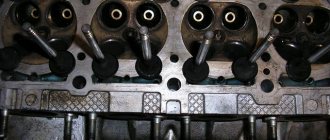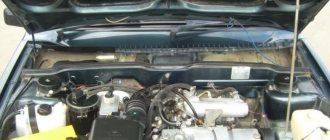We offer services for qualified and safe firmware of engine control units to disable an inoperative USR valve, nitrogen oxide sensor, ADBL system, fuel vapor recovery system, swirl flaps. Reflashing is used in cases where these components do not work or are completely removed from the car. The firmware does not make any changes to the design of the car; only the software of the engine control unit changes. In most cases, this is done by connecting the computer to the OBD II diagnostic connector, without interfering with the wiring, without installing additional devices, without soldering chips and microcircuits.
Disabling the exhaust gas recirculation valve EGR (EGR, Exhaust Gas Recirculation)
The exhaust gas recirculation (EGR) valve connects the intake manifold space behind the throttle to the exhaust manifold space.
Designed to reduce the toxicity of exhaust gases (the content of nitrogen oxides NOx: NO and NO2) at low loads. A portion of the exhaust gas enters the cylinders and causes a decrease in combustion temperature and a decrease in nitrogen oxide emissions. The USR is used on gasoline, diesel and gas engines. If the USR valve malfunctions, the electronic engine control unit records the following errors: P0400 Exhaust gas recirculation system malfunction P0401 Exhaust gas recirculation system inefficiency P0402 Exhaust gas recirculation (EGR) system redundancy P0403 Exhaust gas recirculation system sensor circuit malfunction P0404 EGR system sensor signal is out of range P040 5 Low signal level of EGR sensor "A" P0406 High signal of EGR sensor "A" P0407 Low signal of EGR sensor "B" P0408 High signal of EGR sensor "B"
The appearance of these error codes can be removed forever with the help of reprogramming and without damaging the driving characteristics, components and assemblies. In some cases, additional physical shutdown of the valve is required by installing a gasket and disconnecting the control connector.
Disabling the Nitrogen Oxides (NOx) Sensor
The NOx sensor is used to detect nitrogen oxides in the exhaust gases of engines with direct injection systems and diesel engines with selective catalytic reduction systems.
It is installed behind the storage catalyst (gasoline engines) or the reduction catalyst (diesel engines). The sensor has a separate control unit that amplifies the sensor signals and transmits them to the engine control unit. The nitrogen oxide sensor and the control unit are most often a single unit. If the NOx sensor malfunctions, the ECM records the following errors: P2000 NOx Trap Efficiency Below Threshold P2001 NOx Trap Efficiency Below Threshold P2200 NOx Sensor Circuit Range Exceeded P2201 NOx Sensor Circuits/Performance Low P2202 NOx Sensor Circuit Input Signal Low P2203 NOx Sensor Circuit High P2204 NOx Sensor Circuit Incorrect Signal P2205 NOx Sensor Heater Control Circuit/Open P2206 NOx Sensor Heater Control Circuit Low P2207 NOx Sensor Heater Control Circuit High P2208 NOx Sensor Heater Sense Circuit P2209 NOx Sensor Heater Sense Circuit Range/Low Performance P2210 Sensor NOx Heater Sense Circuit Low Input P2211 NOx Sensor Heater Sense Circuit High Input P2212 NOx Sensor Heater Sense Circuit Intermittent P2213 NOx Sensor Circuit P2214 NOx Sensor Circuit Range/Performance P2215 NOx Sensor Circuit Low Input P2216 NOx Sensor Circuit High Input P2217 NOx Sensor Circuit Intermittent Input P22 18 NOX NOX Control circuit / Open P2219 sensor NOX sensor Heater Control circuit P2220 NOX sensor NOX High -level Control circuit P2221 NOX sensor SENSE SENSE P2222 sensor SENSE SENSE SENSE SENSE / Production P2223 SENS SECTOR SENS SECTOR SCE e chains low level P2224 NOX sensor Heater Sense Circuit High P2225 NOx Sensor Heater Sense Circuit High
These errors are also removed forever by flashing the electronic control unit with a special program, without installing “fake” devices and emulators, as a result of which it will “forget” about the Nox sensor. In some cases, it is necessary to disconnect the sensor control unit from the vehicle's on-board network.
Oxygen sensor
Modern cars contain components that clean the exhaust from substances that are harmful to the environment.
In particular, catalysts and the first oxygen sensors are considered one of such devices. Their job is to analyze the percentage of oxygen in the gases emitted by the engine and transmit this information to the system so that optimal (stoichiometric) conditions can be created based on it. The lower oxygen sensors check the catalyst and also notify the system about its condition. If the element is faulty, the Check Engine icon appears on the dashboard, thereby notifying the driver of the problem. It’s easy to solve – remove the catalyst in Moscow at our service.
When all components are in good working order and perform their functions well, removing the catalyst is not necessary. However, to solve special problems (preparing for long trips, country trips) or when these components are at the limit of their capabilities, there is a need to deactivate them.
Disabling Adblue, urea, selective catalytic reduction systems
A selective catalytic reduction system or selective catalytic reduction system (SCR, Adblue, “urine”, “urea”) is used on diesel engines. It reduces the proportion of nitrogen oxides in the exhaust gases and helps meet Euro 5 and Euro 6 emission standards. The SCR includes a reduction catalyst, pump, tank, injector, mechanical mixer, electronic control system and heating system. Using the firmware of the engine control unit, you can completely disable the entire system and remove it from the car without the appearance of error codes and without compromising driving characteristics or reducing the service life of components and assemblies.
What it is
The optimal composition of the fuel-air mixture contains 1 part gasoline to 14.7 parts atmospheric air. If we take this ratio as one, then its deviation upward/downward indicates an enriched or lean composition of the mixture. For the catalyst to work as efficiently as possible, the deviation from the optimal unit should be no more than one percent.
Technically, the problem is solved by installing a lambda probe built into the electronic fuel supply system, which maintains the composition of the fuel-air mixture in the catalyst within optimal limits.
Disabling the EVAP system
Gasoline vapors form in the fuel tank of a car.
After vapor accumulates in the fuel system and when the engine starts, the vapor escapes through the control valve and adsorber into the intake manifold and subsequent combustion. The EVAP system is used in all modern cars. When the engine is idling or a cold engine is started, the EVAP system prevents vapors from enriching the fuel mixture. If there is a malfunction in the evaporative emission system, the engine's electronic control unit records the following errors: P0440 Evaporative emission control system malfunction P0441 Poor purge of the gasoline vapor emission system P0442 Small leak in the gasoline vapor emission system P0443 Evaporative emission system purge valve circuit malfunction P0444 Evaporative emission system purge valve gasoline vapors are always open P0445 The gasoline vapor recovery system purge valve is always closed P0446 Control malfunction. vapor recovery system air valve P0447 Vapor recovery system air valve is always open P0448 Vapor recovery system air valve is always closed P0450 Gasoline vapor pressure sensor malfunction P0451 Gasoline vapor pressure sensor signal is out of range P0452 Gasoline vapor pressure sensor signal is low P0453 Pressure sensor signal is high gasoline vapor P0454 Intermittent level signal of the gasoline vapor pressure sensor P1441 Flow in the fuel vapor removal system (EVAP) P1442 Evaporative emission control system small leak detected P1443 Evaporative emission control system - vacuum system, purge control solenoid or vapor management valve malfunction P1449 Evaporative emission control system unable to hold vacuum P1455 Evaporative emission control system control leak detected P1655 EVAP solenoid control circuit P1675 EVAP solenoid control circuit
The EVAP system and accompanying errors can be completely disabled using firmware of the engine control unit without the appearance of error codes and without compromising driving characteristics or reducing the service life of components and assemblies.
Types of Catalytic Converters
There are three different types of car catalysts. The first type is an oxidation catalyst. It reduces harmful pollutants such as carbon monoxide (CO) and fuel hydrocarbons (HC) in the exhaust. At the same time, secondary air injection is often used. However, the oxidation catalyst only reduces a portion of the pollutants.
Two stage
The second type is a two-stage catalytic converter, which is more advanced. It works in two stages. There are two elements that are located one after the other.
A two-way (or "oxidation") catalytic converter has two simultaneous tasks:
- Oxidation of carbon monoxide to carbon dioxide: 2CO + O2 → 2CO2.
- Oxidation of hydrocarbons (unburned and partially burned fuel) to carbon dioxide and water: CxH2x + 2 + [(3x + 1) ⁄ 2] O2 → xCO2 + (x + 1) H2O (combustion reaction).
This type of automotive catalyst is widely used in diesel engines to reduce hydrocarbon and carbon monoxide emissions. They were also used on gasoline engines in American and Canadian market vehicles until 1981. Due to their inability to control nitrogen oxides, they were replaced by three-stage converters.
Three-stage
The third type is a three-stage catalytic converter. It began to be used in 1981. It converts harmful gases coming out of the engine into harmless ones.
Engine exhaust gases contain hazardous substances that are harmful to the environment. These include nitrogen oxides, hydrocarbons and carbon monoxide. A three-stage catalyst converts them into less harmful carbon dioxide, water and nitrogen.
The three stages of exhaust gas purification look like this:
- Reduction of nitrogen oxides to nitrogen (N2): 2 CO + 2 NO → 2 CO2 + N2 hydrocarbon + NO → CO2 + H2O + N2 2 H2 + 2 NO → 2 H2O + N2;
- Oxidation of carbon monoxide to carbon dioxide: 2 CO + O2 → 2 CO2;
- Oxidation of unburned hydrocarbons (HC) to carbon dioxide and water in addition to the above reaction NO: hydrocarbon + O2 → H2O + CO2;
These three reactions occur most efficiently when the catalyst receives exhaust from an engine operating slightly above the stoichiometric point. For gasoline combustion, the ratio is 14.6 to 14.8 parts air to one part fuel. Conversion efficiency drops very quickly when the engine is operated outside these limits.
When the mixture is lean, the exhaust contains excess oxygen and this does not contribute to the NOx reduction reaction. In a rich mixture, the excess fuel consumes all the available oxygen ahead of the catalyst, leaving only the oxygen in the catalyst for the oxidation function.
The three-stage converter is the only device that reduces all three pollutants at once. This cleaning method is the most economical.
Most automakers use three-stage converters in their vehicles to meet stringent emission standards.
Disabling the intake manifold swirl flaps
Intake manifold swirl flaps (valves) are installed on most direct injection vehicles.
The purpose of the dampers is to swirl the air flow and improve engine performance at low loads and low speeds. Controlled swirl valves are located in the tangential channels of the suction system and are closed or opened depending on the operating mode. With controlled swirl flaps, the valve controller opens the swirl flaps as the speed increases. If there is a malfunction in the intake manifold swirl flap system, the electronic engine control unit records the following errors: P1017 Intake flaps 2, the upper limit has not been reached P1018 Intake flaps 2: the lower limit has not been reached P1026 Control signal supply to the intake flaps: short circuit to positive P1027 Supply Intake flap control signal: short circuit to ground P1028 Intake flap control signal: open circuit P1029 Intake flap valve-N316: upper limit not reached P1030 Intake flap valve-N316: lower limit not reached P1031 Intake flap valve channels-N316: nominal value not reached P3069 Swirl flap control 2. Adaptation error. P3066 Swirl flap control 1.Adaptation error P3191 Intake flaps: basic mechanical settings are violated. stop in OPEN position. P3192 Intake flaps: basic mechanical settings are violated. stop in CLOSED position. P3193 Intake flaps: stop in OPEN position. outside the scope range P3198 Intake flap control signal: invalid P3199 Intake flap 2 control: invalid P3241 Intake flap: temperature too high P3242 Intake flap 2: temperature too high
The main causes of malfunctions associated with the swirl flap system are carbon coking of the flaps themselves and a malfunction of the servo drive for controlling the position of the flaps.
A large amount of carbon deposits can break the flap, which goes directly into the intake manifold. To restore normal engine operation, we suggest completely disabling the system by flashing the engine control unit. The flaps stop moving. A slight loss of power at low loads is compensated by special software (firmware) installed on the car. ©SVD CHIP Moscow. Reproduction of materials without permission is prohibited.
Technological characteristics of solid catalysts
Lecture 8. Catalysis
1. General ideas about catalysis
2. Technological characteristics of solid catalysts
3. Promotion and poisoning of catalysts
4. Main stages of heterogeneous catalytic processes
General ideas about catalysis
Modern processes of basic inorganic synthesis, oil refining, petrochemistry and organic synthesis are currently impossible to imagine without the use of catalysts. About 90% of industrial chemical technological processes are carried out using catalysts. Examples of inorganic synthesis are: the production of ammonia, nitric and sulfuric acids; petrochemistry and organic synthesis - processes for the production of methanol, styrene, butadiene, phenol and acetone, acetaldehyde, etc. In oil refining - these are the processes of catalytic cracking and reforming, hydrotreating and hydrocracking, isobutane alkylation and isomerization of paraffin hydrocarbons, etc.
Catalytic processes have a number of important advantages over non-catalytic processes. In addition to the fact that the use of catalysts sharply accelerates the rate of chemical reactions, processes using them can be organized as continuous, waste-free and less energy-intensive, characterized by high technical and economic indicators and providing a higher yield of target products.
Catalysts are substances that, repeatedly entering into intermediate interactions with reaction participants, change its mechanism and increase the speed. At the same time, they restore their chemical composition after each cycle of intermediate interactions.
The influence of a catalyst on the mechanism of a chemical reaction can be illustrated by the example of the reaction A + B ® D, which has an activation energy of Eo without a catalyst (Fig. 1). Let's look at the energy diagram of this reaction:
Figure 1 - Energy diagrams of catalytic and non-catalytic
reactions
I and II are the energy levels of the initial reagents and reaction products; 1 - reaction path without a catalyst; 2 —
catalytic reaction pathway
The course of the reaction without a catalyst is shown in the energy diagram by curve 1. In the presence of a catalyst, the reaction mechanism changes, and it proceeds through several successive stages in accordance with curve 2. For example, the first stage may be the formation of the intermediate activated complex AKt:
A + Kt ® AKt, where Kt is a catalyst.
The activated complex then reacts with a second reagent to form a catalyst-product complex:
ACT + B ® DKt.
The last stage is the decomposition of the DKt complex with the formation of product D and the release of the catalyst for a new catalytic cycle:
DKt ® D + Kt.
Each of these successive stages is characterized by its own activation energy values E1, E2, E3, but, as a rule, the height of each of these potential barriers is lower than the activation energy Eо.
Thus, in the presence of a catalyst, the reaction proceeds along an energetically more favorable path, which allows the process to be carried out at a faster rate.
The initial (I) and final (II) energy states of the reaction system in the presence of a catalyst and without it remain the same. Therefore, a catalyst cannot change the state of chemical equilibrium, which is independent of the reaction path .
The role of the catalyst is only to change the rate of reaching the equilibrium state. A catalyst can only increase the rate of processes that are thermodynamically allowed, but cannot initiate thermodynamically impossible reactions.
Some chemical reactions without catalysts are practically impossible due to the activation energy being too high. It would seem that to overcome a high energy barrier it is possible to increase the kinetic energy of molecules, i.e. increase the temperature. But for many reversible exothermic reactions, increasing the temperature shifts the equilibrium in the opposite direction and makes the reaction thermodynamically unresolved. In such cases, the use of a catalyst is not only justified, but also necessary. The catalyst reduces the activation energy of the reaction and thereby allows it to be carried out at significantly lower temperatures. The role of catalysts in the implementation of complex reactions is very important, since catalysts have the ability to selectively influence the rate of only one desired reaction.
As an example, consider the reaction of ammonia synthesis, which is characterized by a very high activation energy (approximately 280 kJ/mol). To overcome such a high energy barrier, the reactants would need to be heated to temperatures above 1000°C, at which the equilibrium degree of conversion, even at very high pressures, is negligible.
In the presence of an iron-based catalyst, the activation energy for ammonia synthesis is reduced to approximately 160 kJ/mol, which allows the process to be carried out at a fairly high speed at temperatures of 400-500°C and high pressures, reaching a 20-35% degree of conversion of the feedstock.
The role of catalysts in complex reactions is extremely important, since catalysts have the ability to selectively influence the rate of only one desired reaction. For example, it is now difficult to imagine the process of cracking petroleum products (a system of complex sequential and parallel reactions) without selectively acting zeolite catalysts, which make it possible to direct the process towards the production of high-quality gasoline.
Catalytic processes are divided into two large groups - homogeneous and heterogeneous. Heterogeneous catalytic processes are most widespread in industry. In turn, the overwhelming majority of heterogeneous catalytic processes are those in which the phase interface is the surface of a solid catalyst located in a gaseous or liquid reaction medium. A significant advantage of such processes is the ease of separation of reaction products and catalyst particles for reuse of the catalyst.
Technological characteristics of solid catalysts
Selecting catalysts for industrial processes is an extremely difficult task. Catalysts are very specific to different chemical reactions. Solid catalysts are, as a rule, highly porous substances with a developed internal surface, characterized by a certain porous and crystalline structure, activity, selectivity and a number of other technological characteristics. The most important characteristics of solid catalysts:
1) Activity is a measure of the accelerating effect of a catalyst in relation to a given reaction. When comparing different catalysts, the more active one is usually chosen if it meets the basic technological requirements. Due to the wide variety of catalytic processes, there is no single quantitative criterion for activity. This is due to the fact that the use of different catalysts, even for the same chemical reaction, can change its mechanism differently. As a rule, the use of a catalyst leads to a change in the reaction order, activation energy, and pre-exponential factor. A quantitative criterion for the activity of a catalyst for a given reaction can be, for example, a rate constant measured for different catalysts under comparable conditions. This approach is applicable if the reaction order remains the same for all compared catalysts of a given group. Sometimes catalysts are compared by reaction rate or by the degree of conversion of reagents under standard conditions, by the number of reagents that interact per unit time on a unit catalyst surface (catalyst productivity or intensity), etc.
2) Selectivity is the ability of a catalyst to selectively accelerate the target reaction in the presence of several side reactions. Complex catalytic reactions can proceed along several thermodynamically possible directions with the formation of a large number of different products. The predominant direction depends on the catalyst used, and the process that is thermodynamically the most favorable of several possible ones is not always accelerated. The selectivity of a catalyst can be quantitatively assessed as the selectivity of the process - integral or differential. Selectivity depends not only on the selected catalyst, but also on the process conditions, on the area of the heterogeneous catalytic process, etc.
If several parallel reactions occur simultaneously, different selective catalysts can be selected for each of these reactions. For example, in the presence of aluminum oxide or thorium oxide, ethanol decomposes predominantly into ethylene and water:
C2H5OH C2H4 + H2O.
In the presence of silver, copper and other metals, practically only the dehydrogenation reaction of alcohol takes place with the formation of acetaldehyde:
C2H5OH CH3CHO + H2.
In the presence of a mixed catalyst (A12O3 + ZnO), dehydration and dehydrogenation reactions occur with sufficiently high selectivity to form butadiene:
2C2H5OH C4H6 + 2H2O + H2.
3) Ignition temperature is the minimum temperature at which the technological process begins to proceed at a speed sufficient for practical purposes. The concept of “ignition” means that when the temperature increases above a limit equal to Tzazh, a sharp, abrupt increase in the reaction rate occurs. Since each catalyst is characterized by its own kinetic parameters, the ignition temperatures will be different for different catalysts. From a technological point of view, it is better to use catalysts with a low ignition temperature, which reduces energy costs for preheating the reaction mixture. It is especially important to have a low ignition temperature of the catalyst when carrying out reversible exothermic reactions, then low temperatures of the process make it possible to shift the equilibrium of the reaction towards the formation of products.
4) Porous structure of the catalyst - characterized by the size and shape of the pores, porosity (the ratio of the free volume of the pores to the total volume), specific surface area (surface area per unit mass or volume). When choosing a solid that should serve as an active catalyst for heterogeneous gas reactions, surface accessibility plays an important role. The larger the surface area available for reacting molecules for a given catalyst, the higher the rate of consumption of reactants per unit time when using the same amount of catalyst. Industrial catalysts always have a developed internal surface, otherwise the very small external surface would quickly be poisoned, and the catalyst would soon lose activity. The higher the porosity of the catalyst and the smaller the pore diameter, the larger the internal surface. Modern catalysts are characterized by large specific surface areas (up to 10-100 m2/g). However, the pore size distribution may be such that part of the catalyst surface is inaccessible to large molecules and, in addition, the rate of conversion of reagents into final products may decrease due to the difficulty of diffusion of reagents within the pores. To obtain catalysts with a developed porous structure, special methods of their preparation are used. They try to use natural or artificial highly porous adsorbents (aluminosilicates, zeolites, silica gel, activated carbon, etc.) as catalysts. These substances are also used as carriers on the surface of which active components are applied.
5) Crystal structure of the catalyst - different crystalline modifications of the same substance can have very different catalytic activity. For example, the transition of -Al2O3 to -Al2O3 (this occurs at a temperature of about 1200°C) reduces the activity of this substance as a catalyst by several orders of magnitude.










